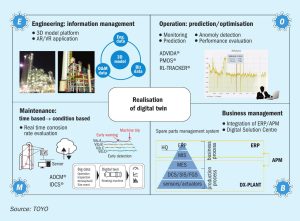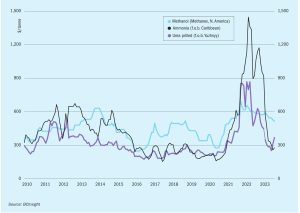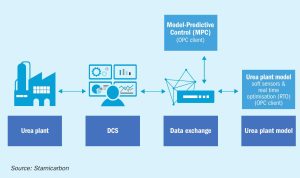
Price Trends
Market Insight courtesy of Argus Media

Market Insight courtesy of Argus Media

CF Fertilisers UK Limited, a subsidiary of CF Industries, says that it plans to permanently close the ammonia plant at its Billingham fertilizer complex in order to secure the long-term sustainability of its business in the UK. The Company intends to continue to produce ammonium nitrate (AN) fertiliser and nitric acid at the Billingham site using imported ammonia, as it has for the last 10 months following its decision to temporarily idle the plant in August 2022.

TOYO’s digital twin concept combines its unique digital twin at both the project execution stage and the commissioning stage, and when used in conjunction with its proprietary process simulator it can predict the whole plant lifecycle.

Ammonia prices have now dropped by about 50% from their highs a year ago. Gas prices have fallen, particularly in Europe, and peak fertilizer application season is over in Europe and North America, leading to slackening demand., leading to slackening demand.

Prior to the covid pandemic, sub-Saharan Africa had been the fastest growing market for new fertilizer demand. However, the combination of pandemic related disruption, followed by the dislocations caused by the war in Ukraine, have pushed up prices and led to falling demand across the continent.

With the growing global demand for food and the rise in ecological challenges, there’s a pressing need for a more sustainable and environmentally-friendly approach to fertilizer production. Achieving a sustainable increase in plant load and operational margins through improved operations is a demanding task. Luc Dieltjens and Ali El Sibai of Stamicarbon discuss how a plant can effectively address these challenges with digital tools to optimise the process.

Ballestra, Nitricity, Solex Thermal Science and Stamicarbon showcase their state-ofthe-art equipment and technologies.

Ammonia production at Billingham in Teesside looks set to end, bringing to a close a history of production that dates back almost a century.

The use of low-chloride fertilizers is a proven strategy for managing chloride sensitivity in crops and avoiding excess chloride in soils. ICL offers a wide range of crop nutrient products for this purpose. Patricia Imas, agronomist at the company, outlines the main options.

Market Insight courtesy of Argus Media. Urea: While prices mostly fell in mid-August, the main development was the massive purchase of Chinese urea by Indian Potash Limited. IPL confirmed that, out of a total tender settlement of 1.759 million tonnes, one million tonnes will be met by Chinese exporters. This far exceeded expectations and added to the already bearish sentiment of most market players.